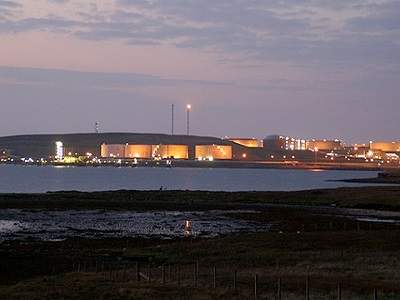
The Shetland Gas Processing plant is part of the Laggan-Tormore project that was developed by Total E&P UK and Dong E&P (UK). The project involved development of the Laggan and Tormore gas / condensate fields on the Shetland Islands and construction of a processing plant to treat the gas produced from the fields. The plant is operated by Total, which owns 80% stake in the project. The remaining 20% is held by Dong.
Construction works at the site commenced in the first half of 2010. The plant came on stream in May 2016. It employed 700 people during construction stage and created 60 to 70 jobs during operations.
Site
The processing plant was built at a 540,000m² site located to the east of the Sullom Voe oil terminal operated by BP. It occupies a 250,000m² area.
Offshore
The plant is connected to the Laggan-Tormore offshore subsea production system.
Reserves / resources
The Laggan and Tormore fields contain gas and condensate reserves exceeding one trillion cubic feet, which is equal to 230 million barrels of oil equivalent (230Mboe).
Connection
The plant imports hydrocarbons, including gas and condensate, produced from the Laggan and Tormore fields through two 143km-long flowlines with an 18in diameter.
Design
The plant is designed for a processing capacity of 500 million cubic feet of gas per day (mcf/d). The gas import pipelines (flowlines) are designed for a capacity of 665mcf/d.
Construction and infrastructure
The plant’s location is characterised by harsh weather conditions. Petrofac has therefore decided to adopt modular approach to construction so that poor weather does not affect the construction activity. The individual plant modules were prefabricated and brought to the site for final assembly.
The site is situated on a steep slope, which requires extensive earthworks. Three terraces were created on the sloping site to create 260,000m² of work platforms to support the plant structure. A total of 600,000m³ of peat was removed to create the terraces. Two peat stores of 500,000m³ were built to accommodate the excavated peat. A 17m-high retaining wall accommodated the remaining peat.
A 2.4km access road has been built to connect the plant to the B9076 road.
A temporary facility was built on a brown field site on Sella Ness to accommodate the construction workers. The accommodation site is located approximately 3km away from the plant site.
By 2011, construction of offices, canteens and other site facilities were completed. In October 2011, civil works including construction of permanent buildings was started. These works were completed by 2013. Piping, mechanical, electrical and other ancillary works commenced in 2012.
A mono-ethylene glycol (MEG) regeneration and recycling unit was built within the plant to reuse the MEG that is injected into the Laggan-Tormore flowlines to prevent possible blockage due to cold climatic conditions.
Processing
The stream of gas and liquid hydrocarbons coming through the flow-lines initially enter a slug catcher to ensure smooth flow. The size of the slug catcher is kept large to accommodate the high volume of liquid hydrocarbons.
The gas and liquid are separated in a three-phase separation process. The output stream from the slug catcher reaches the first separator where the gas is siphoned off due to light weight and the heavier fluid is retained by gravity. It is then put through the second phase of separation to further dehydrate the gas and compress for export.
The liquid hydrocarbons output from the first phase are preheated and sent to the third phase of separation which separates any remaining gas associated with them.
The third separator removes any water or MEG, ensuring that the condensate is suitable for export.
Output
The gas output from the plant is sent to St Fergus Terminal near Peterhead for final processing.
Pipeline route
A new pipeline of 665mcf/d capacity was built to export the processed gas to a tie-in point on the Frigg UK (FUKA) pipeline, which is situated approximately 230km south of the plant. The tie-in line, named the Shetland Island Regional Gas Export System (SIRGE), is a 243km-long pipeline of 30in diameter.
The FUKA pipeline transfers the gas to St Fergus Gas Terminal operated by Total, for further processing.
Contractors
A £34m contract was awarded to Roadbridge in March 2010 to carry out the site preparation works and construct the access road. As part of the contract, Roadbridge also installed a sewerage treatment plant along with surface run-off drainage systems.
The engineering, procurement, supply, construction and commissioning (EPSCC) contract for the plant was awarded to Petrofac’s offshore engineering and operations (OE&O) unit in October 2010. The contract is valued at £500m.
Archial was appointed as the architect for the temporary accommodation facility.
Corus supplied the pipe sections for the SIRGE line, as well as the import flowlines as part of a £200m contract signed in 2010. Bredero Shaw, the coating division of ShawCor, provided protective coatings to the inner walls of the pipes, under a subcontract received from Corus UK.
Nuovo Pignone supplied high-pressure gas export compressor packages for the project.
Morrison Construction was awarded a £50m contract by Petrofac in June 2011 to carry out civil infrastructure works, including underground drainage facilities, roads and buildings.
Aker Solutions was awarded a contract in October 2012 to provide operations and maintenance services for the plant for three years.



